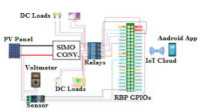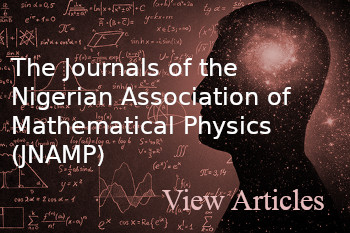MONITORING AND CONTROL OF DOMESTIC DC LOADS CONNECTED TO SINGLE INPUT MULTIPLE OUTPUTS (SIMO) DC–DC CONVERTER USING IoT
DOI:
https://doi.org/10.60787/tnamp-19-245-256Keywords:
IoT, DC-DC converter, Flyback, Inductor, Switch, Transformer, ferrite-core, PWM; SIMOAbstract
Photovoltaic (PV) power generation, utilization and home automation and domestic loads control are exciting fields that are exploding the recent technologies. Internet of Things (IoT) provides an attractive and technological platform to connect the two and make home automation and domestic energy utilization easier and attractive. This paper presents the use of IoT-based control topology to monitor and control power distribution and consumption by DC loads connected to single-input multiple outputs (SIMO) DC-DC converter, thereby reducing leakages, enhancing performance and reducing human efforts. A SIMO converter was first developed and integrated with the IoT/Raspberry Pi control topology, which enable the user to monitor and control power scheduling and load forecasting via an android app. The two systems were developed and tested with a reliable and convincing solution to home automation and loads management. Demands and supply were recorded by the user via mobile app created to monitor the management and control. The recorded data are plotted and shows how the two react to changes in solar energy supply and demands by the loads.
Downloads
References
Al-Nimr, M., I. Al-Darawsheh, and L. AL-Khalayleh, A novel hybrid cavity solar thermal collector. Renewable Energy, 2018. 115: p. 299-307.
Liu, H., Control Design of a Single-Phase DC/AC Inverter for PV Applications. 2016.
Cui, T., Y. Xuan, and Q. Li, Design of a novel concentrating photovoltaic–thermoelectric system incorporated with phase change materials. Energy Conversion and Management, 2016. 112: p. 49-60.
Hamdan, M.A. and L.A. Al-Qudah, Performance Improvement of Shallow Solar Pond Using Nanoparticles. Int. J. of Thermal & Environmental Engineering, 2016. 11(1): p. 00-00.
Al‐Nimr, M.d.A., S. Kiwan, and H. Sharadga, Simulation of a novel hybrid solar photovoltaic/wind system to maintain the cell surface temperature and to generate electricity. International Journal of Energy Research.
Yadav, A.K. and S. Chandel, Identification of relevant input variables for prediction of 1-minute time-step photovoltaic module power using Artificial Neural Network and Multiple Linear Regression Models. Renewable and Sustainable Energy Reviews, 2017. 77: p. 955-969.
Eke, R. and T.R. Betts, Spectral irradiance effects on the outdoor performance of photovoltaic modules. Renewable and Sustainable Energy Reviews, 2017. 69: p. 429-434.
Kawano, A. and K. Goto, Dc-dc converter. 2017, Google Patents.
Sivakumar, S., et al., An assessment on performance of DC–DC converters for renewable energy applications. Renewable and Sustainable Energy Reviews, 2016. 58: p. 1475-1485.
Forouzesh, M., et al., Step-Up DC–DC Converters: A Comprehensive Review of Voltage-Boosting Techniques, Topologies, and Applications. IEEE Transactions on Power Electronics, 2017. 32(12): p. 9143-9178.
Zhang, K., Z. Shan, and J. Jatskevich, Large-and small-signal average-value modeling of dual-active-bridge DC–DC converter considering power losses. IEEE Transactions on Power Electronics, 2017. 32(3): p. 1964-1974.
Lu, D., Y. Qian, and Z. Hong. 4.3 An 87%-peak-efficiency DVS-capable single-inductor 4-output DC-DC buck converter with ripple-based adaptive off-time control. in Solid-State Circuits Conference Digest of Technical Papers (ISSCC), 2014 IEEE International. 2014. IEEE.
Deboy, G. and A. Sanders, Post-regulated flyback converter with variable output stage. 2017, Google Patents.
Monfared, M., S. Golestan, and J.M. Guerrero, Analysis, design, and experimental verification of a synchronous reference frame voltage control for single-phase inverters. IEEE Transactions on Industrial Electronics, 2014. 61(1): p. 258-269.
Yang, Y., H. Wang, and F. Blaabjerg, Reactive power injection strategies for single-phase photovoltaic systems considering grid requirements. IEEE Transactions on Industry Applications, 2014. 50(6): p. 4065-4076.
Adhikari, S. and F. Li, Coordinated Vf and PQ control of solar photovoltaic generators with MPPT and battery storage in microgrids. IEEE Transactions on Smart Grid, 2014. 5(3): p. 1270-1281.
Zong, X., A single phase grid connected DC/AC inverter with reactive power control for residential PV application. 2011.
Peña, J.C., et al. Robust control of a single-phase VSI with LCL filter for grid-tie and islanded operation modes applied to PV distributed generation in microgrids environment. in Energy Conversion Congress and Exposition (ECCE), 2014 IEEE. 2014. IEEE.
Umuhoza, J., et al. Optimizing efficiency and performance for single-phase photovoltaic inverter with Dual-Half Bridge converter Yuzhi Zhang. in 2015 IEEE Applied Power Electronics Conference and Exposition (APEC).
Zhang, Y., et al. Realizing an integrated system for residential energy harvesting and management. in Applied Power Electronics Conference and Exposition (APEC), 2015 IEEE. 2015. IEEE.
Jang, M., M. Ciobotaru, and V.G. Agelidis, A single-phase grid-connected fuel cell system based on a boost-inverter. IEEE transactions on power electronics, 2013. 28(1): p. 279-288.
Cha, H. and T.-K. Vu. Comparative analysis of low-pass output filter for single-phase grid-connected Photovoltaic inverter. in Applied Power Electronics Conference and Exposition (APEC), 2010 Twenty-Fifth Annual IEEE. 2010. IEEE.
Chiang, H.-C. and H.-Y. Tsai, Design and implementation of a grid-tied wind power micro-inverter. IET Renewable Power Generation, 2013. 7(5): p. 493-503.
Clemmer, T., et al. Design and evaluation of a next generation residential energy management system. in Power Electronics for Distributed Generation Systems (PEDG), 2013 4th IEEE International Symposium on. 2013. IEEE.
Hui, T.K., R.S. Sherratt, and D.D. Sánchez, Major requirements for building Smart Homes in Smart Cities based on Internet of Things technologies. Future Generation Computer Systems, 2017. 76: p. 358-369.
Bevrani, H. and T. Hiyama, Intelligent automatic generation control. 2016: CRC press.
Vale, Z., et al., Computational intelligence applications for future power systems. Computational intelligence for engineering systems, 2011: p. 176-193.
Fozdar, M., C. Arora, and V. Gottipati. Recent trends in intelligent techniques to power systems. in Universities Power Engineering Conference, 2007. UPEC 2007. 42nd International. 2007. IEEE.
Alata, M., M. Al-Nimr, and Y. Qaroush, Developing a multipurpose sun tracking system using fuzzy control. Energy Conversion and
Management, 2005. 46(7): p. 1229-1245.
Babakmehr, M., et al. Designing an intelligent low power residential pv-based microgrid. in Industry Applications Society Annual Meeting, 2016 IEEE. 2016. IEEE.
Yue, J., et al., Economic power schedule and transactive energy through an intelligent centralized energy management system for a DC residential distribution system. Energies, 2017. 10(7): p. 916.
Yoon, J.H., R. Baldick, and A. Novoselac, Demand response control of residential HVAC loads based on dynamic electricity prices and economic analysis. Science and Technology for the Built Environment, 2016. 22(6): p. 705-719.
Kelly, S.D.T., N.K. Suryadevara, and S.C. Mukhopadhyay, Towards the implementation of IoT for environmental condition monitoring in homes. IEEE Sensors Journal, 2013. 13(10): p. 3846-3853.
Gubbi, J., et al., Internet of Things (IoT): A vision, architectural elements, and future directions. Future generation computer systems, 2013. 29(7): p. 1645-1660.
Sundmaeker, H., et al., Vision and challenges for realising the Internet of Things. Cluster of European Research Projects on the Internet of Things, European Commision, 2010. 3(3): p. 34-36.
Vermesan, O., et al., Internet of things strategic research roadmap. Internet of Things-Global Technological and Societal Trends, 2011. 1(2011): p. 9-52.
Hong, S., et al., SNAIL: an IP-based wireless sensor network approach to the internet of things. IEEE Wireless Communications, 2010. 17(6).
Bui, N., et al., The internet of energy: a web-enabled smart grid system. IEEE Network, 2012. 26(4).
Gluhak, A., et al., A survey on facilities for experimental internet of things research. IEEE Communications Magazine, 2011. 49(11): p. 58-67.
Zorzi, M., et al., From today's intranet of things to a future internet of things: a wireless-and mobility-related view. IEEE Wireless communications, 2010. 17(6).
Sehgal, A., et al., Management of resource constrained devices in the internet of things. IEEE Communications Magazine, 2012. 50(12).
Hu, Q. and F. Li, Hardware design of smart home energy management system with dynamic price response. IEEE Transactions on Smart grid, 2013. 4(4): p. 1878-1887.
Lee, I. and K. Lee, The Internet of Things (IoT): Applications, investments, and challenges for enterprises. Business Horizons, 2015. 58(4): p. 431-440.
Zhao, C.W., J. Jegatheesan, and S.C. Loon, Exploring iot application using raspberry pi. International Journal of Computer Networks and Applications, 2015. 2(1): p. 27-34.
Holler, J., et al., From Machine-to-machine to the Internet of Things: Introduction to a New Age of Intelligence. 2014: Academic Press.
Vujović, V. and M. Maksimović, Raspberry Pi as a Sensor Web node for home automation. Computers & Electrical Engineering, 2015. 44: p. 153-171.
Schmidt, M., Raspberry Pi: a quick-start guide. 2014: Pragmatic Bookshelf.
Shannon, C.E., A symbolic analysis of relay and switching circuits. Electrical Engineering, 1938. 57(12): p. 713-723.
Rashidi, S., J.A. Esfahani, and A. Rashidi, A review on the applications of porous materials in solar energy systems. Renewable and Sustainable Energy Reviews, 2017. 73: p. 1198-1210.

Downloads
Published
Issue
Section
License
Copyright (c) 2024 The Transactions of the Nigerian Association of Mathematical Physics

This work is licensed under a Creative Commons Attribution-NonCommercial 4.0 International License.



